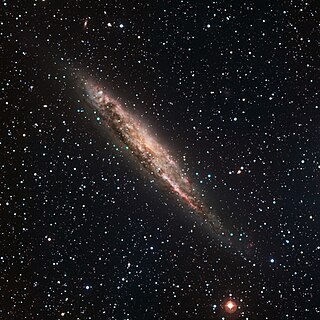NGC 4945
| NGC 4945 | |
|---|---|
 NGC 4945 image take by the MPG/ESO 2.2-metre telescope at La Silla Observatory | |
| Observation data (J2000 epoch) | |
| Constellation | Centaurus |
| Right ascension | 13h 05m 27.5s[1] |
| Declination | −49° 28′ 06″[1] |
| Redshift | 563 ± 3 km/s[1] |
| Distance | 11.7 Mly (3.6 Mpc)[2] |
| Apparent magnitude (V) | 9.3[1] |
| Characteristics | |
| Type | SB(s)cd[1] |
| Apparent size (V) | 20′.0 × 3′.8[1] |
| Other designations | |
| PGC 45279,[1] Caldwell 83 | |
Coordinates: ![]() 13h 05m 27.5s, −49° 28′ 06″
13h 05m 27.5s, −49° 28′ 06″

The location of NGC 4945 (labelled in red)
NGC 4945 (also known as Caldwell 83) is a barred spiral galaxy in the constellation Centaurus, visible near the star Xi Centauri.[3] The galaxy was discovered by James Dunlop in 1826 and is thought to be similar to the Milky Way Galaxy, although X-ray observations show that NGC 4945 has an unusual energetic Seyfert 2 nucleus that might house a supermassive black hole.[4] This object has an estimated mass of 1.4+1.4
−0.7×106 M☉.[5]
Galaxy group[]
NGC 4945 one of the brightest galaxies of the Centaurus A/M83 Group, a large, nearby group of galaxies. The galaxy is the second brightest galaxy in the subgroup centered on Centaurus A.[2][6]
In popular culture[]
NGC 4945 is the title of a song by Brett Domino on the album "Funk".
References[]
- ^ Jump up to: a b c d e f g "NASA/IPAC Extragalactic Database". Results for NGC 4945. Retrieved 2006-11-25.
- ^ Jump up to: a b I. D. Karachentsev; M. E. Sharina; A. E. Dolphin; E. K. Grebel; et al. (2002). "New distances to galaxies in the Centaurus A group". Astronomy and Astrophysics. 385 (1): 21–31. Bibcode:2002A&A...385...21K. doi:10.1051/0004-6361:20020042.
- ^ http://www.docdb.net/show_object.php?id=ngc_4945, NGC 4945 : DOCdb :Deep Sky Observer's Companion – the online database
- ^ "Milky Way's Not-So-Distant Cousin Likely Harbors Supermassive Black Hole". Science Daily.
- ^ Graham, Alister W. (November 2008), "Populating the Galaxy Velocity Dispersion - Supermassive Black Hole Mass Diagram: A Catalogue of (Mbh, σ) Values", Publications of the Astronomical Society of Australia, 25 (4): 167–175, arXiv:0807.2549, Bibcode:2008PASA...25..167G, doi:10.1071/AS08013, S2CID 89905.
- ^ I. D. Karachentsev (2005). "The Local Group and Other Neighboring Galaxy Groups". Astronomical Journal. 129 (1): 178–188. arXiv:astro-ph/0410065. Bibcode:2005AJ....129..178K. doi:10.1086/426368.
External links[]
| Wikimedia Commons has media related to NGC 4945. |
- NGC 4945 on WikiSky: DSS2, SDSS, GALEX, IRAS, Hydrogen α, X-Ray, Astrophoto, Sky Map, Articles and images
- APOD: Nearby Spiral Galaxy NGC 4945 (7/21/02)
- ESO: The milkyway's nearby cousin (2/10/09)
Categories:
- Barred spiral galaxies
- Centaurus A/M83 Group
- Centaurus (constellation)
- NGC objects
- Principal Galaxies Catalogue objects
- Caldwell objects
- Astronomical objects discovered in 1826